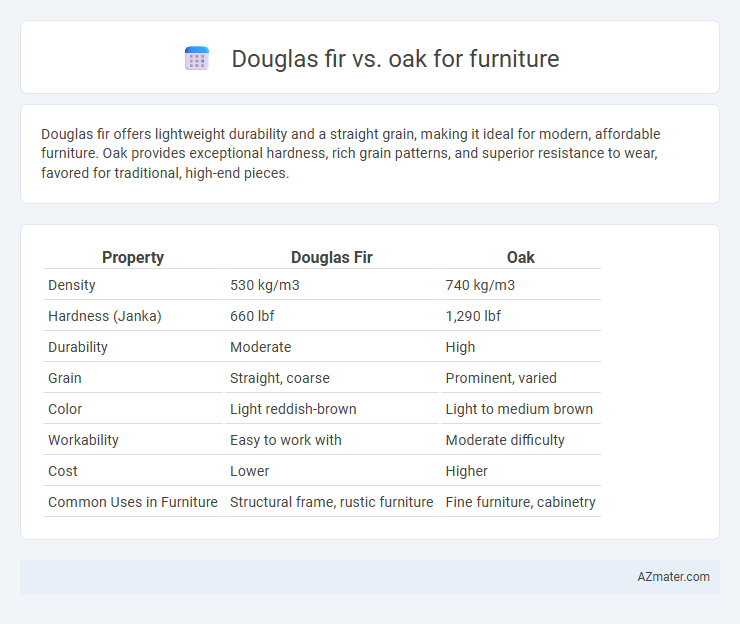Douglas fir offers lightweight durability and a straight grain, making it ideal for modern, affordable furniture. Oak provides exceptional hardness, rich grain patterns, and superior resistance to wear, favored for traditional, high-end pieces.
Table of Comparison
| Property | Douglas Fir | Oak |
|---|---|---|
| Density | 530 kg/m3 | 740 kg/m3 |
| Hardness (Janka) | 660 lbf | 1,290 lbf |
| Durability | Moderate | High |
| Grain | Straight, coarse | Prominent, varied |
| Color | Light reddish-brown | Light to medium brown |
| Workability | Easy to work with | Moderate difficulty |
| Cost | Lower | Higher |
| Common Uses in Furniture | Structural frame, rustic furniture | Fine furniture, cabinetry |
Overview: Douglas Fir vs Oak in Furniture Making
Douglas fir offers lightweight durability and a warm, reddish-brown hue, making it ideal for rustic and contemporary furniture with visible grain patterns. Oak features exceptional hardness and strength, paired with a distinct grain, providing long-lasting furniture often favored for traditional and high-traffic pieces. Both woods excel in stability and versatility, but oak's higher density delivers superior resistance to wear, while Douglas fir's affordability and ease of work appeal to budget-conscious projects.
Wood Characteristics: Grain, Color, and Texture
Douglas fir features a straight, pronounced grain with a light reddish-brown hue, offering a more uniform and smooth texture ideal for rustic or modern furniture styles. Oak displays a prominent, swirling grain pattern with warm golden to deep brown tones, providing a coarse texture that highlights natural wood character and durability. The choice between Douglas fir and oak depends on desired aesthetics, with Douglas fir presenting a softer feel and oak delivering a robust, classic appearance.
Durability and Strength Comparison
Douglas fir offers exceptional strength with a Janka hardness rating of approximately 660, making it a durable choice for furniture that withstands daily use. Oak, particularly red or white oak, ranks higher on the hardness scale, around 1,290 to 1,360, providing superior resistance to dents and scratches. For long-lasting furniture, oak is preferred for its robust density and longevity, while Douglas fir is valued for lightweight strength and affordability.
Workability: Ease of Cutting and Shaping
Douglas fir is renowned for its excellent workability due to its straight grain and medium softness, making it easier to cut, shape, and sand compared to many hardwoods. Oak, being a dense hardwood with a prominent grain, demands more effort and sharper tools to achieve precise cuts and smooth finishes. Consequently, Douglas fir is often preferred in furniture projects requiring intricate detailing and faster production, while oak is selected for durability despite its more challenging workability.
Finishing Capabilities: Stain and Paint Receptiveness
Douglas fir features a coarse grain and open pores, which absorb stain unevenly, resulting in a less uniform finish, while its natural reddish hue can alter stain colors. Oak's dense grain structure and well-defined rings provide excellent stain receptiveness, producing rich and consistent finishes, making it ideal for both staining and painting. Paint adheres reliably to both woods, but oak's smooth surface ensures a more flawless and durable painted finish compared to Douglas fir.
Cost Analysis: Price Differences
Douglas fir offers a more budget-friendly option for furniture, with prices typically 30-50% lower than oak due to its faster growth rate and abundant supply. Oak, prized for its durability and rich grain patterns, commands higher prices that reflect its slower maturation and greater demand. When considering cost-effectiveness in furniture making, Douglas fir provides significant savings without compromising on structural strength, while oak represents a long-term investment with enhanced aesthetic value.
Sustainability and Sourcing
Douglas fir offers a more sustainable option for furniture due to its fast growth rate and wide availability in North American forests, enabling responsible harvesting and quicker regeneration compared to oak. Oak, while prized for its durability and aesthetic appeal, often comes from slower-growing trees, making sustainable sourcing more challenging and sometimes leading to higher environmental impact. Choosing Douglas fir supports eco-friendly practices through reduced carbon footprint and enhanced forest management policies, making it a preferred choice for environmentally conscious furniture production.
Common Uses in Furniture Design
Douglas fir is widely favored for outdoor furniture and structural pieces due to its strength, durability, and resistance to decay, making it ideal for patio sets, benches, and rustic designs. Oak, known for its dense grain and hardness, is commonly used in high-end indoor furniture such as dining tables, cabinets, and flooring, offering exceptional wear resistance and classic aesthetic appeal. Both woods serve distinct purposes: Douglas fir excels in functional, weather-exposed applications, while oak is prized for elegant, long-lasting interior furnishings.
Maintenance and Longevity
Douglas fir offers moderate durability with a maintenance routine that includes regular sealing to prevent moisture damage, making it prone to dents and scratches compared to hardwoods. Oak, renowned for its exceptional hardness and resistance to wear, requires less frequent upkeep and maintains its structural integrity and appearance over decades. The dense grain of oak also better withstands everyday use, resulting in longer-lasting furniture with minimal refinishing needs.
Final Verdict: Choosing Between Douglas Fir and Oak
Douglas fir offers lightweight strength and a warm, rustic look ideal for casual furniture, while oak provides superior hardness and durability with a classic grain suited for heirloom pieces. Oak resists dents and scratches better, making it preferable for high-traffic or heavily used furniture, whereas Douglas fir is easier to work with and more cost-effective. The final verdict depends on whether the priority is long-lasting wear and traditional aesthetics (oak) or affordability and ease of customization (Douglas fir).

Infographic: Douglas fir vs Oak for Furniture
 azmater.com
azmater.com